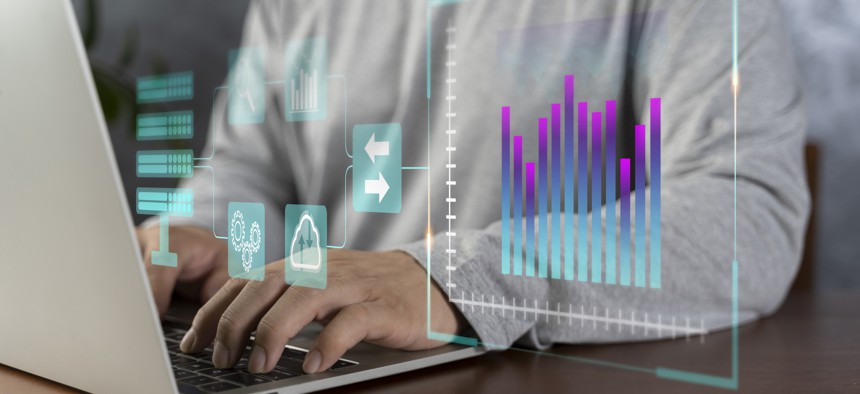SAFHER cloud-based platform for regulating food and agriculture comes closer to fruition

jittawit.21/Getty Images
The System for Agriculture, Food, Health, E-Inspections, and Registration enterprise platform will replace the legacy systems USA Food Safety and USA Plants.
A next-generation, cloud-based system for helping state and local officials manage regulating food and agriculture moved a step closer to fruition this month when the team coordinating it selected an implementation manager and technology platform.
When it comes to food safety, states have similar regulations and processes that sometimes create gaps or duplication in the data. To streamline the regulatory process and make data sharing easier across states, the Association of Food and Drug Officials (AFDO), a nonprofit regulatory organization, is developing the System for Agriculture, Food, Health, E-Inspections, and Registration (SAFHER).
The enterprise platform will replace the legacy systems USA Food Safety and USA Plants, and states and local regulatory agencies will be able to use SAFHER for licensing, inspections, complaints, compliance, reporting and enforcement related to programs such as retail food, agriculture, animal food, manufactured food and pesticides.
The platform is designed to provide states an offramp from legacy systems, Rich Medina Colorado, director of technology for the Colorado Department of Agriculture, said in a introductory video. The multitenant SAFHER will allow states to easily do the work they have in common, and flexible, low-code/no code programs will allow them to customize processes. It also will allow states to share information, bringing business intelligence to bear on the process, he said.
On Jan. 11, the team announced that it had selected Precise Software Solutions as the implementation manager and Appian as the technology platform. AFDO is working with 26 agencies in 20 states on the project.
The new system will address several challenges that state and local agencies face with existing technology, said Kellie Isaac, SAFHER director and chief innovation officer at AFDO.
First, when policies change, agencies currently wait for developers to update regulatory systems, which can take time that states can’t always afford. “This will be a core solution that has standardization of business processes and data to reduce costs,” Isaac said. SAFHER will also allow states to quickly make custom changes, she said.
Second, SAFHER will make it easier for states to set up user-friendly digital services such as portals that the public can use to interact with food and drug safety officials to request a license to open a restaurant, register a pet food or lodge a complaint.
“It’s enabling the population to file complaints and be able to communicate with their state officials and also share that information out across the area,” Isaac said.
Third, AFDO is working on standardizing data and creating data governance and data-sharing policies. Datasets include restaurant and grocery store licensing and registration, inspection reports, food and agricultural data, and consumer complaints.
“To share data, you need normal data … data that’s consistent,” she said. “Everybody understands the definition of risk and is using the same definition and is quantifying it the same way.”
All told, SAFHER will provide state-of-the-art technology that states wouldn’t be able to afford on their own, Isaac said. Costs will depend on the number of programs and users, and AFDO will work on pricing formulas in the next few months, said Steven Mandernach, the organization’s executive director.
“We have yet to find the state whose annual costs wouldn’t be less than $200,000,” Mandernach said. That’s close to AFDO’s estimates that initial configuration and data migration would cost $35,000 to $110,000, with annual ongoing maintenance and licensing ranging from $110,000 to $160,000.
SAFHER is funded by a cooperative agreement from the federal Food and Drug Administration worth about $18 million and spanning three years. A fully functional pilot will be ready within about 18 months, and partner states will transition to the system within 28 months, he said.
SAFHER builds on previous systems. Twenty-some years ago, Pennsylvania pioneered the idea of building data systems that could be used across programs and states, Mandernach said. That led to the formation of USA Food Safety and USA Plants, which are used for agricultural regulation programs such as for pesticides and fertilizer.
The effort revealed efficiencies and cost savings, two things he expects to increase with SAFHER. “People at one point were very possessive of their own processes,” he said. “I think that the era of process improvement has really come into government now, and they’re understanding that we can probably do things better. And there’s a whole lot of benefit for us using very similar processes to our neighbor, as most of our customers are not just within our state or our local jurisdiction.”
What’s more, SAFHER will future-proof the work, Earl Thornton, member of the project governing council and IT Director of the Louisiana Department of Agriculture and Forestry, said in a press release.
“Designed from the ground up, it will provide what we all need to regulate within the agricultural and food safety arenas,” Thornton said of SAFHER. “It’s based on state-of-the-art-technology that will benefit us today and into the future. It will also benefit from the best ideas of so many organizations and will continue to grow as the regulatory landscape changes over time.”
Stephanie Kanowitz is a freelance writer based in northern Virginia.





